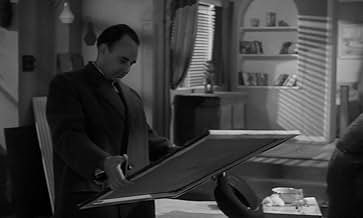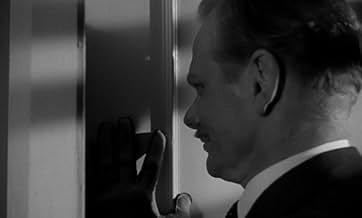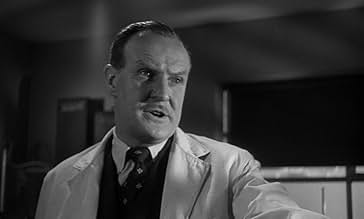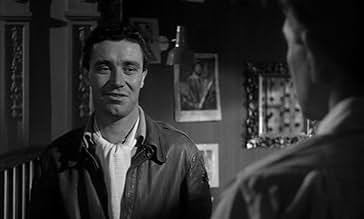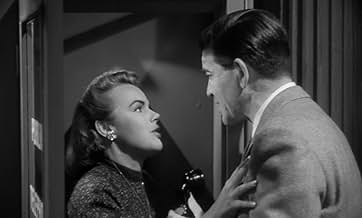A woman's painted portrait and a post card with a sketch of a woman's hand holding a Chianti bottle are the main clues used by the Scotland Yard to solve a string of murders connected to a d... Read allA woman's painted portrait and a post card with a sketch of a woman's hand holding a Chianti bottle are the main clues used by the Scotland Yard to solve a string of murders connected to a diamond-smuggling ring.A woman's painted portrait and a post card with a sketch of a woman's hand holding a Chianti bottle are the main clues used by the Scotland Yard to solve a string of murders connected to a diamond-smuggling ring.
- Director
- Writers
- Stars
Gerald Andersen
- Police Doctor
- (uncredited)
- Director
- Writers
- All cast & crew
- Production, box office & more at IMDbPro
Featured reviews
With its distant echoes of Laura, Postmark for Danger (a.k.a. Portrait of Alison) survives as one of the few English crime dramas of the post-war period with some of the grit and menace of American film noir. (Americans, plus one Canadian, make up the principal cast. But the film betrays its British provenance with its assumption of the utter incorruptibility of the London police - a notion that wouldn't pass muster on the west side of the Atlantic - as well as with its the-butler-did-it resolution.)
Robert Beatty, a commercial artist, hears some bad news from his pilot-for-hire brother (William Sylvester): a third brother has died in a fiery car crash in Italy, along with a young actress he had met. Then strange things begin to happen: The police grow interested in a postcard his dead brother may have sent him, as do elements of the underworld; and the father of the actress commissions him to paint a portrait, working from a photograph, of his daughter. Next, he returns to find the portrait vandalized, the photograph missing, and his favorite model dead in his bedroom, wearing the gown in the painting. He becomes the prime suspect in the murder when no evidence can be found to support his wild claims - until the supposedly dead actress (Terry Moore) shows up at his door.
At the end of the day, Postmark for Danger settles down into a tidy police procedural about a ring of diamond smugglers. But for much of its course it unfurls in a tantalizing mist of eerie and unlikely coincidences, many of them centering on the word `nightingale.' Credit should probably go to director Guy Green, who started out as a cinematographer (he shot David Lean's Great Expectations). It's an enjoyable if minor entry, albeit one with just a little bit extra.
Robert Beatty, a commercial artist, hears some bad news from his pilot-for-hire brother (William Sylvester): a third brother has died in a fiery car crash in Italy, along with a young actress he had met. Then strange things begin to happen: The police grow interested in a postcard his dead brother may have sent him, as do elements of the underworld; and the father of the actress commissions him to paint a portrait, working from a photograph, of his daughter. Next, he returns to find the portrait vandalized, the photograph missing, and his favorite model dead in his bedroom, wearing the gown in the painting. He becomes the prime suspect in the murder when no evidence can be found to support his wild claims - until the supposedly dead actress (Terry Moore) shows up at his door.
At the end of the day, Postmark for Danger settles down into a tidy police procedural about a ring of diamond smugglers. But for much of its course it unfurls in a tantalizing mist of eerie and unlikely coincidences, many of them centering on the word `nightingale.' Credit should probably go to director Guy Green, who started out as a cinematographer (he shot David Lean's Great Expectations). It's an enjoyable if minor entry, albeit one with just a little bit extra.
This UK film from 1955 opens with a car racing along the road, over the cliff it goes, and bursts into flames when it hits the canyon below. Geoffrey Keen is Inspector Cobly, who is investigating the accident. We are introduced to Tim and Dave, the brothers of the deceased driver. You'll recognize "Henry" (Allan Cuthbertson) from Fawlty Towers, and whole lot of British TV. I see Hopscotch (AWESOME film) in Cuthberson's list of roles, but can't remember what he did in it. Tim (Robert Beatty) also starts checking out what's going on, and he bumps into people who have the answers, but don't want to give them up. Terry Moore stars as Alison, and seems to be at the center of all this grand adventure. Pretty entertaining. I've never seen this one before, and as of today, doesn't have any comments on the discussion board. Must be new to Turner Classics. There is a twist here and there, but nothing earth shattering. Story by Francis Durbridge, who wrote this in between all the (British) TV series for which he was known. Directed by Guy Green, who had received an Oscar for directing the 1948 Great Expectations.
Pretty good crime caper.
It's far from perfect and has some silly bits in it, but this movie is still a pretty good ride. It also has a topnotch cast of British and American actors to distract nicely from some otherwise hamfisted fight scenes, a rather muddled and implausible plot and a cheesy ending.
It's a supposedly British film but even though it has UK locations it comes across as a fairly typical American noir. The director, Guy Green, is British but clearly took his cues from America for this one. There is also an uncomfortable and misguided attempt to try to capture the mid-50s London scene.
Robert Beatty is well suited to his role and doesn't overdo the wrongly suspected victim. Lots of interesting parts for movie buffs and 'face watchers' to enjoy. Even 'Captain Peacock' (Frank Thornton) from Are You Being Served makes a brief appearance! (Those Sunday nights watching PBS weren't wasted after all, eh?)
Like I say, there's a certain amount of silliness but it still holds up nicely because of the crisp pacing and superior acting talent on display.
It's far from perfect and has some silly bits in it, but this movie is still a pretty good ride. It also has a topnotch cast of British and American actors to distract nicely from some otherwise hamfisted fight scenes, a rather muddled and implausible plot and a cheesy ending.
It's a supposedly British film but even though it has UK locations it comes across as a fairly typical American noir. The director, Guy Green, is British but clearly took his cues from America for this one. There is also an uncomfortable and misguided attempt to try to capture the mid-50s London scene.
Robert Beatty is well suited to his role and doesn't overdo the wrongly suspected victim. Lots of interesting parts for movie buffs and 'face watchers' to enjoy. Even 'Captain Peacock' (Frank Thornton) from Are You Being Served makes a brief appearance! (Those Sunday nights watching PBS weren't wasted after all, eh?)
Like I say, there's a certain amount of silliness but it still holds up nicely because of the crisp pacing and superior acting talent on display.
Francis Durbridge shines through with his special knack for women mysteries and their magic presence for being absent, you are reminded both of the Paul Temple series and "Melissa" and other spellbinding thrillers with mystical ladies, and here you have two of them murdered while one of them shows up not being murdered at all.
The intrigue is spun around a portrait, a weird old man commissions Robert Beatty, a poor painter and brother of the first casualty of the racket, to paint his lost daughter from a picture of her, which task gets him into thorough trouble, especially since one of his earlier models is found murdered in his flat.
It's not a bad film although somewhat superficial, of such an intrigue Hitchcock would have brought out a masterpiece, the action is a bit thick as too many things are happening at the same time and too many threads are being woven together in some confusion, as there is another casualty of a man jumping out of a window and lots of fisticuffs which at least twice completely demolishes the painter's entire flat - there is not much space to fight, but they do it the more thoroughly.
In brief, a very entertaining thriller with some magic in it, but you would have preferred the first girl (Josephine Griffin) to Terry Moore, but that's a matter of personal taste..
The intrigue is spun around a portrait, a weird old man commissions Robert Beatty, a poor painter and brother of the first casualty of the racket, to paint his lost daughter from a picture of her, which task gets him into thorough trouble, especially since one of his earlier models is found murdered in his flat.
It's not a bad film although somewhat superficial, of such an intrigue Hitchcock would have brought out a masterpiece, the action is a bit thick as too many things are happening at the same time and too many threads are being woven together in some confusion, as there is another casualty of a man jumping out of a window and lots of fisticuffs which at least twice completely demolishes the painter's entire flat - there is not much space to fight, but they do it the more thoroughly.
In brief, a very entertaining thriller with some magic in it, but you would have preferred the first girl (Josephine Griffin) to Terry Moore, but that's a matter of personal taste..
Robert Beatty is an artist who learns that his brother has been killed in a Italian car accident. As you'd expect, that's just the start of it - the mystery revolves around a postcard featuring a glass of Chianti being held in a woman's hand... Who has it? What does it mean? Is it a clue to the mysterious death? This is a far more layered thriller than you'd expect - the performances are taut and the dialogue less meandering than in many other UK-made dramas of the time. Geoffrey Keen is good as the sceptical police inspector and although you do get the gist well before the end, it's still quite a suspensefully directed (by Guy Green) 80 minutes.
Did you know
- TriviaWilliam Lucas played the same role in the 1955 TV serial.
- GoofsThe layout of the hotel where Mr. Smith is staying is not consistent with his death. If the stairs leading to his floor end in a direction towards the rear of the building, then his room faced the rear and he could not have fallen out onto the front sidewalk. If the stairs leading to his floor loop around again and end facing the front, his room would have been in the opposite direction from where he fell on the sidewalk.
- Quotes
Fenby: He was a good scout Lewis, everybody liked him.
Tim Forrester: Evidently somebody didn't.
- ConnectionsReferences Laura (1944)
- How long is Postmark for Danger?Powered by Alexa
Details
- Release date
- Countries of origin
- Languages
- Also known as
- Postmark for Danger
- Filming locations
- London, Greater London, England, UK(location-shooting)
- Production company
- See more company credits at IMDbPro
- Runtime1 hour 24 minutes
- Color
- Aspect ratio
- 1.66 : 1
Contribute to this page
Suggest an edit or add missing content


